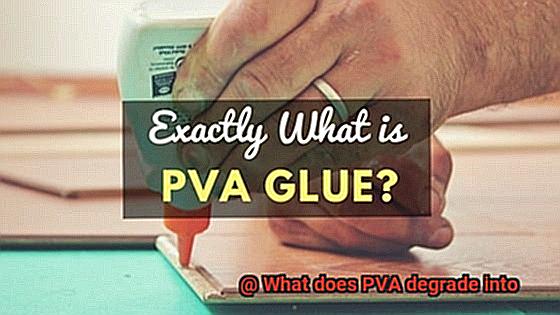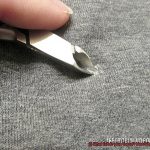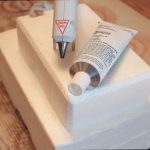Have you ever stopped to think about what happens to the products we use every day once we’ve discarded them? Common items like plastic bags, straws, and toothbrushes can take centuries to degrade if not disposed of properly, adding to the pollution crisis. One material that’s gained popularity in recent years is polyvinyl alcohol, or PVA.
But what exactly is PVA and what happens when it degrades? PVA is a synthetic polymer that’s used in a variety of industrial and consumer applications due to its high strength, durability, and adhesive properties. From agriculture to textiles, PVA has become a go-to ingredient for many products.
However, this wonder substance isn’t without its drawbacks. When PVA breaks down over time, it turns into microplastics – small pieces of plastic that are often too tiny to see with the naked eye. These microplastics can easily make their way into soil and waterways where they can harm wildlife and the environment.
So how can we reduce the amount of PVA and other plastics in our environment? The answer may lie in promoting more sustainable alternatives like biodegradable plastics and reusable products. By being mindful of the materials we use and their impact on our world, we can all do our part to create a cleaner future.
What is PVA?
Contents
Polyvinyl acetate (PVA) is a synthetic polymer that has transformed the adhesive industry. Widely used as an adhesive and glue, PVA is a water-soluble glue that dries clear and forms a flexible bond, making it an ideal choice for numerous applications.
Discovered in Germany by Fritz Klatte in 1912, PVA was initially used as a fabric coating to make them more durable and water-resistant. However, in the 1930s, PVA evolved into an incredibly versatile adhesive that catered to woodworking, bookbinding, and other applications.
PVA comes in various forms such as white glue, school glue, wood glue, and even fabric glue. It is also used in industries like papermaking, packaging, and construction. One of the most significant advantages of PVA is its low toxicity and the fact that it does not emit harmful fumes.
One unique property of PVA is its transparency when dry. This makes it a perfect choice for applications where appearance is crucial, such as woodworking projects or arts and crafts.
While PVA is highly effective over time, it can degrade and lose its adhesive properties depending on temperature, humidity levels, and pH levels of the environment. To maintain its effectiveness, users should store PVA-based products in cool and dry places.
Another factor that affects the degradation of PVA is light exposure. Ultraviolet (UV) light breaks down the chemical bonds in PVA much faster than normal conditions. Manufacturers recommend storing PVA-based products in opaque containers or keeping them out of direct sunlight.
What Does PVA Degrade Into?
Polyvinyl acetate, or PVA, is a synthetic polymer that is widely used as an adhesive in the woodworking, paper and packaging, and textiles industries. However, PVA is not immune to degradation. Over time, this adhesive can break down and weaken, which can affect its overall effectiveness.

So what happens when PVA degrades? The answer depends on several factors such as the type of PVA, storage conditions, usage conditions and the duration of use. In general, PVA can degrade into three different compounds: acetic acid, vinyl acetate monomer (VAM), and water.
Acetic acid is one of the most common byproducts of PVA degradation. This compound is corrosive and can cause damage to certain materials over time. When acetate groups break down in PVA due to heat or moisture exposure, acetic acid is released.
Another possible byproduct of PVA degradation is VAM. This compound is a hazardous substance that can cause health problems if ingested or inhaled in large quantities. VAM is a key component in the production of PVA but can also be released when PVA breaks down.
Finally, water is another byproduct of PVA degradation. The breakdown of acetate groups releases H2O molecules into the surrounding environment. While water itself is not harmful, it can weaken the adhesive properties of PVA over time and cause it to lose its effectiveness.
To minimize negative effects of PVA degradation, it’s important to monitor the degradation of PVA products and handle them with care. Proper disposal of PVA products is also necessary to prevent any negative health or environmental impacts.
Factors that Affect the Rate of PVA Degradation
Temperature is one of the most crucial factors that influence the rate of PVA degradation. High temperatures accelerate the process of PVA breakdown. At temperatures above 60°C (140°F), PVA starts to break down rapidly, losing its adhesion properties. It’s critical to store your PVA glue in a cool and dry place to extend its shelf life.
Humidity is another crucial factor that affects the rate of PVA degradation. In environments with high humidity, PVA absorbs water molecules and softens over time. As a result, the glue bond weakens, leading to failure eventually. To avoid this, it’s best to use PVA glue in dry environments or seal the surfaces with a waterproof coating.
Exposure to UV light is also a significant factor that affects the rate of PVA degradation. When exposed to direct sunlight or UV radiation, PVA’s molecular structure begins to break down, causing it to lose its adhesive properties. It’s essential to protect your PVA glue from direct sunlight or UV radiation and store it in a dark place.
To summarize, several factors impact the rate of PVA degradation, including temperature, humidity, and exposure to UV light. Storing your PVA glue in a cool and dry place will prolong its lifespan, and using it in dry environments or sealing surfaces with waterproof coatings will prevent moisture absorption. Finally, protecting your PVA glue from direct sunlight or UV radiation will keep it effective for longer.
The Dangers of VAM Exposure
When exposed to certain conditions, PVA can break down and release harmful chemicals such as vinyl acetate monomer (VAM). VAM is classified as a Group 2A carcinogen, meaning it is likely to cause cancer in humans.
But the dangers of VAM exposure don’t stop there. Long-term exposure to this chemical can also cause respiratory problems and skin irritation. Workers who regularly use PVA products in manufacturing plants or industrial settings are particularly at risk.
It’s important to note that not all PVA products degrade into VAM at the same rate. The amount and rate of degradation depend on various factors such as the type of PVA, the conditions of use, and the presence of other chemicals in the product. Nonetheless, it’s still crucial for consumers and workers alike to take appropriate safety measures when handling PVA products.
What can you do to protect yourself from VAM exposure? First and foremost, always follow the safety guidelines provided by the manufacturer. If you work with PVA products regularly, consider wearing protective gear such as gloves and a respirator. Additionally, storing PVA products in a cool, dry place away from direct sunlight or UV radiation can help prolong their adhesive properties and reduce the risk of VAM exposure.
How to Prolong the Effectiveness of PVA Adhesives
PVA adhesives are a go-to for many DIY projects and industries alike due to their strong bonding properties. However, like any other adhesive, PVA adhesives can lose their effectiveness over time. Fortunately, there are some tips and tricks you can follow to ensure that your PVA adhesive remains effective for longer.
Firstly, proper storage is essential. Keep your PVA adhesive in a cool and dry place away from direct sunlight and heat sources. Heat and moisture can cause the adhesive to break down and lose its bonding strength. Therefore, it’s crucial to store it at a consistent temperature.
Secondly, using an expired adhesive can lead to poor bonding and even damage the materials being bonded together. Therefore, make sure to use the adhesive within its shelf life. The shelf life may vary depending on the brand and type of adhesive, so check the label carefully.
Thirdly, applying the adhesive correctly is crucial. Applying too little or too much adhesive can affect its bonding strength. It is recommended to follow the manufacturer’s instructions carefully and apply the adhesive evenly on both surfaces being bonded together. Also, ensure that the surfaces are clean and free from dust, dirt, and grease.
Fourthly, using a primer or sealer before applying the adhesive can improve its bonding strength. The primer or sealer can help seal porous surfaces and create a better surface for the adhesive to bond with. You could also add a small amount of vinegar or glycerin to the adhesive to slow down the drying process and prevent it from becoming brittle over time.
Accelerating the Degradation of PVA with Light
PVA adhesives are versatile and reliable for all kinds of DIY projects and industries. However, like any superhero, PVA has its own kryptonite. Light is the ultimate arch-nemesis that can accelerate the degradation of PVA and lead to its downfall. As an expert on this topic, I will explain how light affects PVA and what you can do to avoid its negative impacts.
The chromophores present in PVA are responsible for its degradation when exposed to light. These molecules absorb UV light and transfer energy to the surrounding polymer chains, causing them to break down. This ultimately leads to a brittle texture and eventual crumbling of the PVA. The rate of degradation depends on various factors, such as the intensity and duration of light exposure, as well as the concentration of chromophores in the PVA.
However, not all lights are equally effective in breaking down PVA. UV light within the range of 240-280 nm is most potent in accelerating the degradation process. Visible light or longer wavelengths of UV light may not have a significant effect on PVA degradation.
Although accelerating the degradation of PVA with light is useful, it’s essential to consider its potential drawbacks. Prolonged exposure to UV light can cause discoloration and reduced tensile strength, affecting the properties of PVA negatively. Therefore, it’s crucial to consider specific conditions required for effective degradation and any potential effects on the properties of PVA.
Proper storage, usage before shelf life expires, and application techniques are necessary to keep your PVA strong like Captain America’s shield. Ensure that you store your PVA in a cool and dry place away from direct sunlight or any other sources of light that could trigger its degradation. Use it before its shelf life expires and follow proper application techniques as recommended by the manufacturer.
YHwCPnC0nso” >
Conclusion
To sum up, polyvinyl alcohol (PVA) is a synthetic polymer that has gained immense popularity due to its remarkable strength, durability, and adhesive properties. However, PVA is not invincible and can deteriorate over time, resulting in the formation of microplastics that can cause harm to wildlife and the environment. To mitigate the amount of PVA and other plastics in our surroundings, it is vital to embrace sustainable alternatives such as biodegradable plastics and reusable products.
Several factors impact the rate at which PVA degrades, including temperature, humidity, and exposure to UV light. To prolong its lifespan, proper storage in a cool and dry place away from direct sunlight or heat sources is necessary. Moreover, using an expired adhesive or applying it incorrectly can lead to poor bonding strength; therefore, carefully following the manufacturer’s instructions is crucial.
It’s also essential to consider potential health hazards associated with PVA degradation. Vinyl acetate monomer (VAM), a hazardous substance that can cause respiratory problems and skin irritation, may be released when PVA breaks down. Therefore, taking appropriate safety measures when handling PVA products is necessary.
In conclusion, creating a cleaner future necessitates being mindful of the materials we use and their impact on our world.






